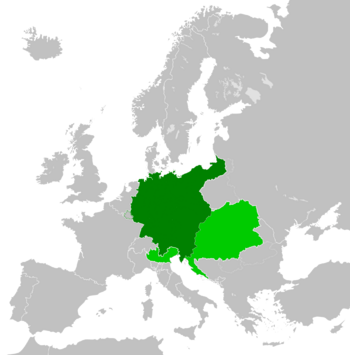German Federation
German Federation Deutscher Bund (German) | |||||||
|---|---|---|---|---|---|---|---|
| 1850–1918 | |||||||
Ensign
(See also Flags of the German Federation) | |||||||
| Motto: Sein Vaterland muss größer sein! | |||||||
| Anthem: Hymne der Deutschen "Hymn of the Germans" | |||||||
 The territory of the German Federation throughout its existence. Austrian-controlled lands outside the federation are shown in light green. | |||||||
| Capital | Multiple | ||||||
| Largest city | Berlin | ||||||
| Official languages | German | ||||||
| Common languages | Polish, Czech, Italian, Slovenian, French, Sorbian | ||||||
| Demonym(s) | German | ||||||
| Government | Federal semi-constitutional parliamentary diarchy (1866 - 1918) | ||||||
• King-Emperor-Kaiser of Germany & Austria |
| ||||||
• King-Emperor of Germany and Prussia |
| ||||||
| Legislature | Bundestag | ||||||
| Formation and History | |||||||
| History | |||||||
| 8 June, 1815 | |||||||
| 12 January 1848 - 4 October 1849 | |||||||
| February 1848 - July 1849 | |||||||
• Frankfurt Constitution and the establishment of the German Empire | 28 March, 1849 | ||||||
• Second Frankfurt Constitution & proclamation of the German Federation | 20 March, 1850 | ||||||
• Prussia joins the German Federation | 22 July, 1866 | ||||||
| 1881 | |||||||
• Assassination of Wilhelm II of Prussia | 1912 | ||||||
| 1912 - 1918 | |||||||
• Dissolution into the North German Federation and South German Federation | 11 November, 1918 | ||||||
• Established | 20 March 1850 | ||||||
• Dissolution | 11 November 1918 | ||||||
| Currency | Vereinsthaler | ||||||
| ISO 3166 code | DE | ||||||
| |||||||
This article is incomplete because it is pending further input from participants, or it is a work-in-progress by one author. Please comment on this article's talk page to share your input, comments and questions. Note: To contribute to this article, you may need to seek help from the author(s) of this page. |
The German Federation, informally called the German Empire or as Germany, was a German-dominated nation-state in Europe from 1850 to its dissolution in 1918. Forming out of the efforts of revolutionaries across Germany, the Federation established a unified German nation under the hegemony of Austria, although with the joining of a downsized Prussia in 1866 this was later relegated to a diarchy.
Unstable even before Prussia's union with the Federation, the German Federation was an attempt to satisfy both the liberals and conservatives of Germany, resulting in a workable yet unsatisfactory solution to unification. As a federal monarchy, its members maintained limited control over their lands and retained their monarchies, though ultimate authority lied with Prussia and Austria, whose rulers were titled King-Emperor and King-Emperor-Kaiser respectively. Conflicts between the catholic Austria and the protestant Prussia led to instability in the Federation, reaching an unbearable high in the early 20th century with the rule of Wilhelm II in Prussia.
The German Federation participated in the Scramble for Africa, colonizing areas of modern day East Africa as well as modern day Lower Volta, its colonies however would shortly after the Europakrieg be partitioned among France and the United Kingdom. Germany's entrance into the Europakrieg would lead to its dissolution by the hands of the Entente and its partition.
Name & Terminology
The official name of the Federation in German was Deutscher Bund, synonymous with the German name for the preceding German Confederation. Popularly though unofficially, Germany during this time was referred to as the Deutscher Bundesreich to distinguish itself from the German Confederation. Other popular names include Großdeutschland (lit. "Greater Germany"), and Deutscher Bundesland (German Federal State / "Federal State of Germany")